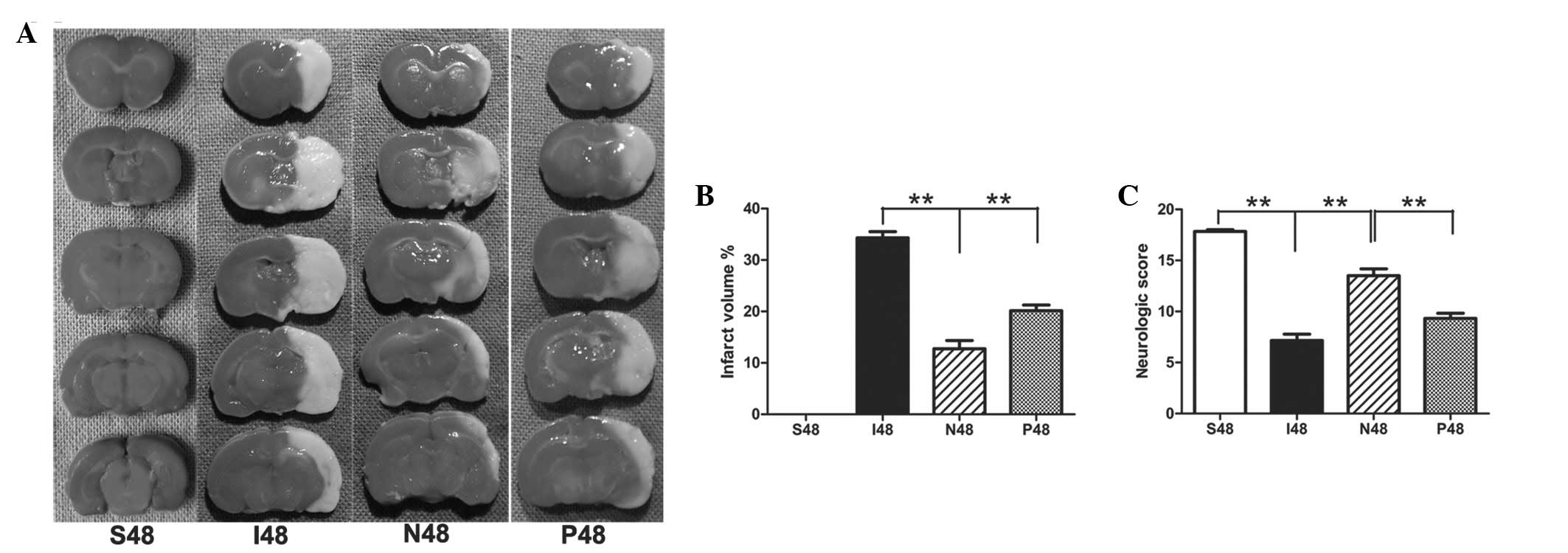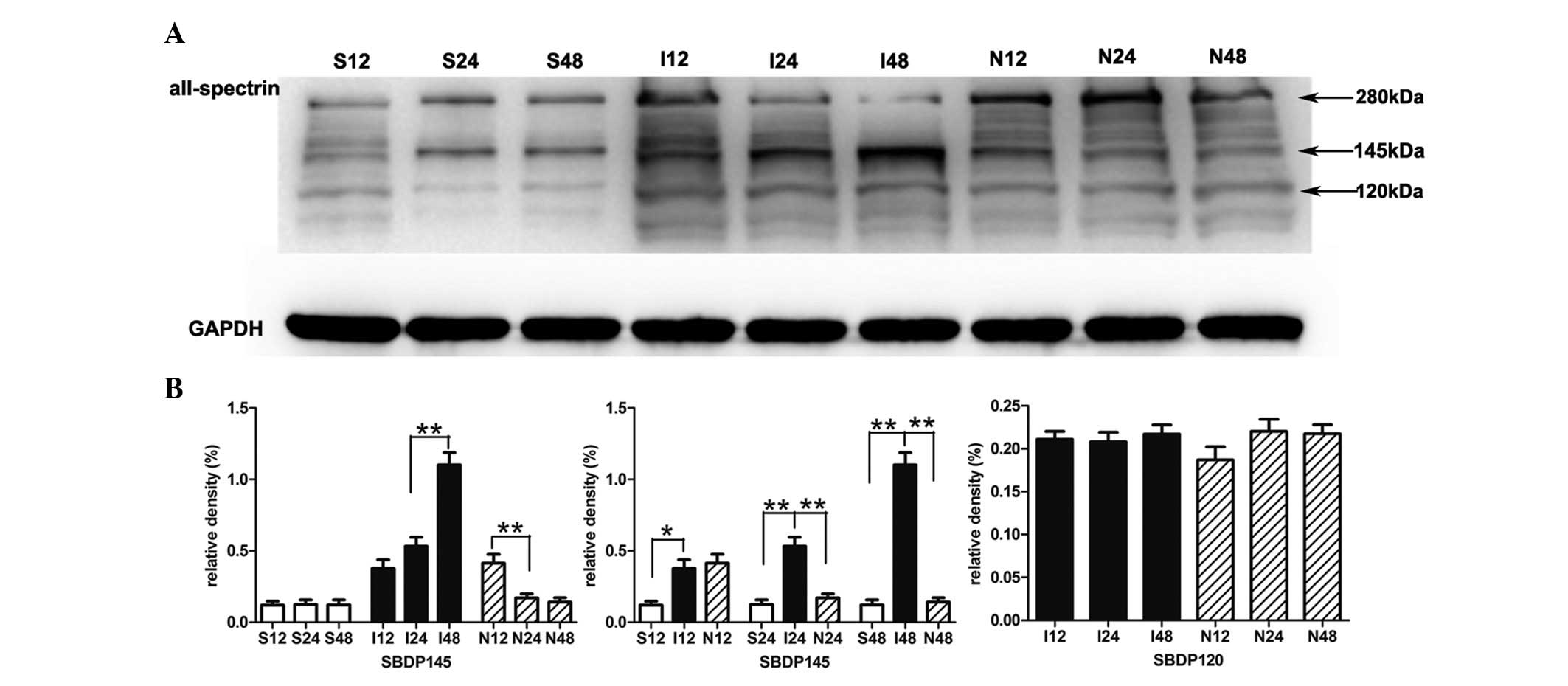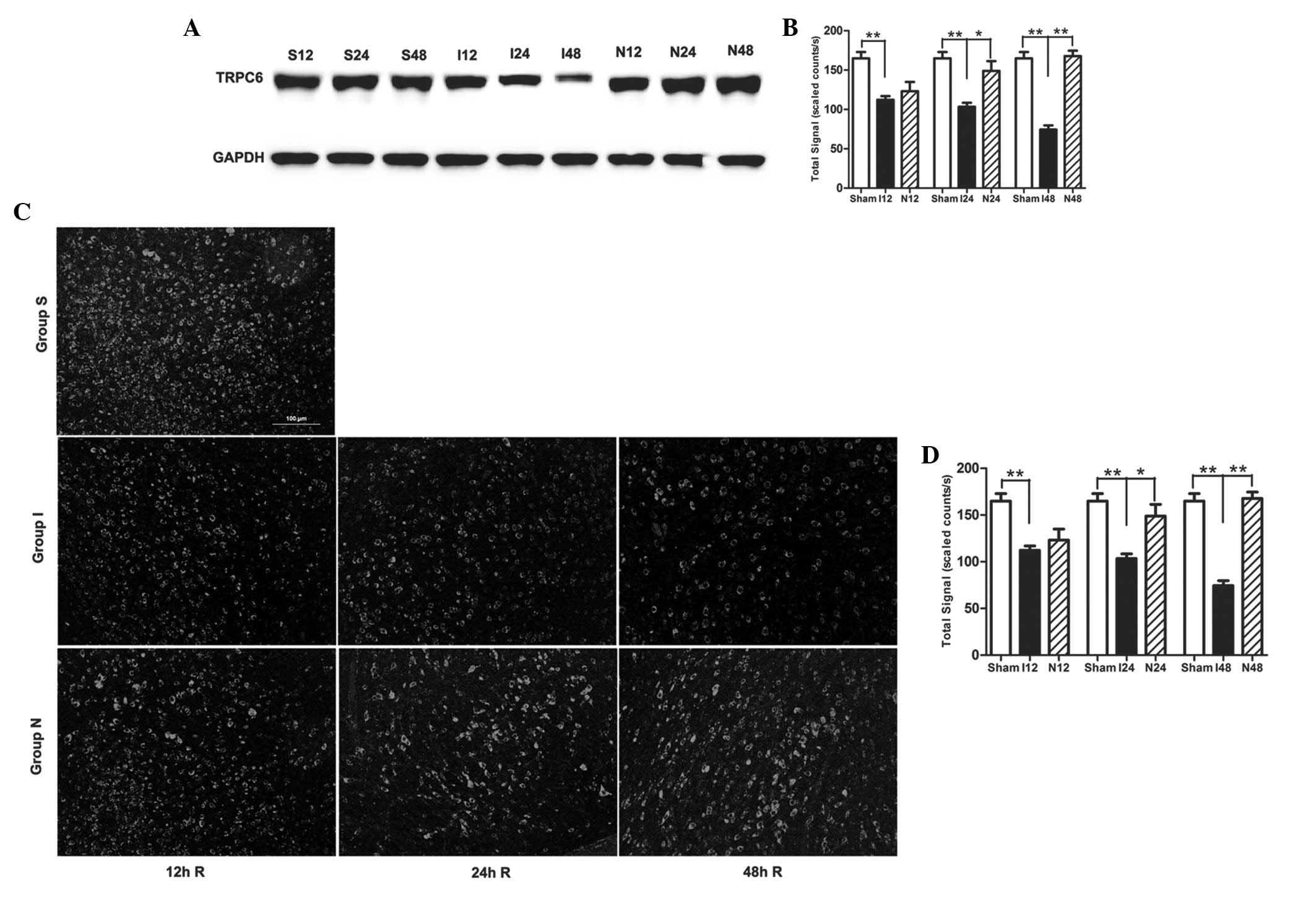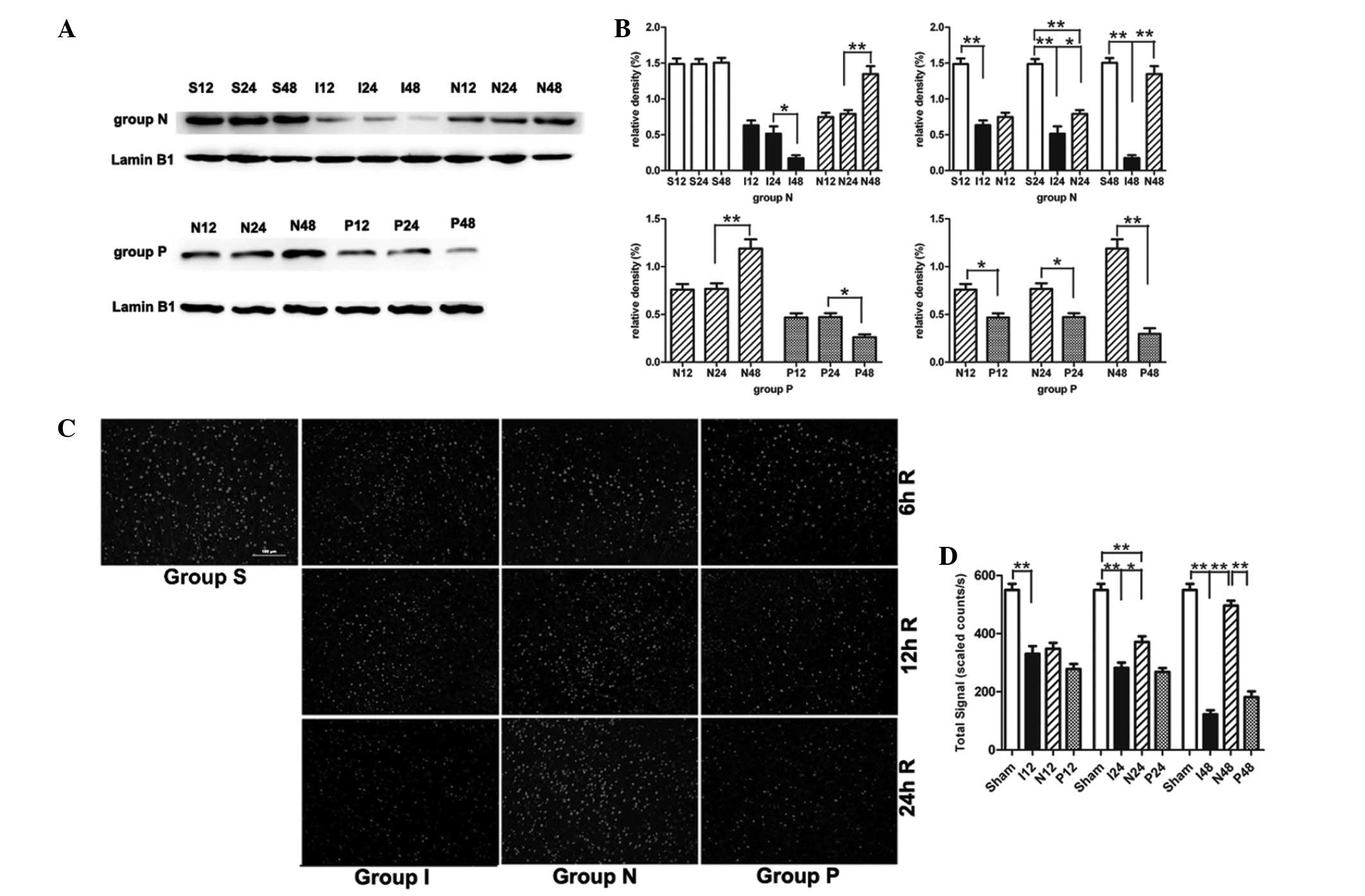|
1
|
Dirnagl U, Iadecola C and Moskowitz MA:
Pathobiology of ischaemic stroke: an integrated view. Trends
Neurosci. 22:391–397. 1999. View Article : Google Scholar : PubMed/NCBI
|
|
2
|
Lo EH, Dalkara T and Moskowitz MA:
Mechanisms, challenges and opportunities in stroke. Nat Rev
Neurosci. 4:399–415. 2003. View
Article : Google Scholar : PubMed/NCBI
|
|
3
|
Lo EH: A new penumbra: transitioning from
injury into repair after stroke. Nat Med. 14:497–500. 2008.
View Article : Google Scholar : PubMed/NCBI
|
|
4
|
Choi DW: Ischemia-induced neuronal
apoptosis. Curr Opin Neurobiol. 6:667–672. 1996. View Article : Google Scholar
|
|
5
|
Lipton P: Ischemic cell death in brain
neurons. Physiol Rev. 79:1431–1568. 1999.PubMed/NCBI
|
|
6
|
Bartus RT, Dean RL, Cavanaugh K, Eveleth
D, Carriero DL and Lynch G: Time-related neuronal changes following
middle cerebral artery occlusion: implications for therapeutic
intervention and the role of calpain. J Cereb Blood Flow Metab.
15:969–979. 1995. View Article : Google Scholar
|
|
7
|
Lipton SA and Rosenberg PA: Excitatory
amino acids as a final common pathway for neurologic disorders. N
Engl J Med. 330:613–622. 1994. View Article : Google Scholar : PubMed/NCBI
|
|
8
|
Du W, Huang J, Yao H, Zhou K, Duan B and
Wang Y: Inhibition of TRPC6 degradation suppresses ischemic brain
damage in rats. J Clin Invest. 120:3480–3492. 2010. View Article : Google Scholar : PubMed/NCBI
|
|
9
|
Jia Y, Zhou J, Tai Y and Wang Y: TRPC
channels promote cerebellar granule neuron survival. Nat Neurosci.
10:559–567. 2007. View
Article : Google Scholar : PubMed/NCBI
|
|
10
|
Simopoulos AP: Omega-3 fatty acids, the
brain and retina. Preface. World Rev Nutr Diet. 99:VII–XII.
2009.PubMed/NCBI
|
|
11
|
Niemoller TD, Stark DT and Bazan NG:
Omega-3 fatty acid docosahexaenoic acid is the precursor of
neuroprotectin D1 in the nervous system. World Rev Nutr Diet.
99:46–54. 2009. View Article : Google Scholar : PubMed/NCBI
|
|
12
|
Marcheselli VL, Hong S, Lukiw WJ, et al:
Novel docosanoids inhibit brain ischemia-reperfusion-mediated
leukocyte infiltration and pro-inflammatory gene expression. J Biol
Chem. 278:43807–43817. 2003. View Article : Google Scholar
|
|
13
|
Bazan NG: Cell survival matters:
docosahexaenoic acid signaling, neuroprotection and photoreceptors.
Trends Neurosci. 29:263–271. 2006. View Article : Google Scholar : PubMed/NCBI
|
|
14
|
Belayev L, Marcheselli VL, Khoutorova L,
et al: Docosahexaenoic acid complexed to albumin elicits high-grade
ischemic neuroprotection. Stroke. 36:118–123. 2005. View Article : Google Scholar : PubMed/NCBI
|
|
15
|
Rodriguez DTE, Belayev L, Liu Y, et al:
Systemic fatty acid responses to transient focal cerebral ischemia:
influence of neuroprotectant therapy with human albumin. J
Neurochem. 83:515–524. 2002. View Article : Google Scholar : PubMed/NCBI
|
|
16
|
Bazan NG: Homeostatic regulation of
photoreceptor cell integrity: significance of the potent mediator
neuroprotectin D1 biosynthesized from docosahexaenoic acid: the
Proctor Lecture. Invest Ophthalmol Vis Sci. 48:4866–4881.
4864–4865. 2007. View Article : Google Scholar : PubMed/NCBI
|
|
17
|
Tsubokawa T, Jadhav V, Solaroglu I,
Shiokawa Y, Konishi Y and Zhang JH: Lecithinized superoxide
dismutase improves outcomes and attenuates focal cerebral ischemic
injury via antiapoptotic mechanisms in rats. Stroke. 38:1057–1062.
2007. View Article : Google Scholar : PubMed/NCBI
|
|
18
|
Shen H, Chen GJ, Harvey BK, Bickford PC
and Wang Y: Inosine reduces ischemic brain injury in rats. Stroke.
36:654–659. 2005. View Article : Google Scholar : PubMed/NCBI
|
|
19
|
Shen H, Kuo CC, Chou J, et al: Astaxanthin
reduces ischemic brain injury in adult rats. Faseb J. 23:1958–1968.
2009. View Article : Google Scholar : PubMed/NCBI
|
|
20
|
Hardingham GE, Fukunaga Y and Bading H:
Extrasynaptic NMDARs oppose synaptic NMDARs by triggering CREB
shut-off and cell death pathways. Nat Neurosci. 5:405–414.
2002.PubMed/NCBI
|
|
21
|
Goll DE, Thompson VF, Li H, Wei W and Cong
J: The calpain system. Physiol Rev. 83:731–801. 2003. View Article : Google Scholar
|
|
22
|
Yao H, Ginsberg MD, Eveleth DD, et al:
Local cerebral glucose utilization and cytoskeletal proteolysis as
indices of evolving focal ischemic injury in core and penumbra. J
Cereb Blood Flow Metab. 15:398–408. 1995. View Article : Google Scholar : PubMed/NCBI
|
|
23
|
Hong SC, Goto Y, Lanzino G, Soleau S,
Kassell NF and Lee KS: Neuroprotection with a calpain inhibitor in
a model of focal cerebral ischemia. Stroke. 25:663–669. 1994.
View Article : Google Scholar : PubMed/NCBI
|
|
24
|
Roberts-Lewis JM, Savage MJ, Marcy VR,
Pinsker LR and Siman R: Immunolocalization of calpain I-mediated
spectrin degradation to vulnerable neurons in the ischemic gerbil
brain. J Neurosci. 14:3934–3944. 1994.PubMed/NCBI
|
|
25
|
von Reyn CR, Spaethling JM, Mesfin MN, et
al: Calpain mediates proteolysis of the voltage-gated sodium
channel alpha-subunit. J Neurosci. 29:10350–10356. 2009.
|
|
26
|
Montell C, Jones K, Hafen E and Rubin G:
Rescue of the Drosophila phototransduction mutation trp by germline
transformation. Science. 230:1040–1043. 1985. View Article : Google Scholar : PubMed/NCBI
|
|
27
|
Harteneck C, Plant TD and Schultz G: From
worm to man: three subfamilies of TRP channels. Trends Neurosci.
23:159–166. 2000. View Article : Google Scholar : PubMed/NCBI
|
|
28
|
Montell C, Birnbaumer L and Flockerzi V:
The TRP channels, a remarkably functional family. Cell.
108:595–598. 2002. View Article : Google Scholar : PubMed/NCBI
|
|
29
|
Li Y, Jia YC, Cui K, et al: Essential role
of TRPC channels in the guidance of nerve growth cones by
brain-derived neurotrophic factor. Nature. 434:894–898. 2005.
View Article : Google Scholar : PubMed/NCBI
|
|
30
|
Tai Y, Feng S, Ge R, et al: TRPC6 channels
promote dendritic growth via the CaMKIV-CREB pathway. J Cell Sci.
121:2301–2307. 2008. View Article : Google Scholar : PubMed/NCBI
|
|
31
|
Sossin WS and Barker PA: Something old,
something new: BDNF-induced neuron survival requires TRPC channel
function. Nat Neurosci. 10:537–538. 2007. View Article : Google Scholar : PubMed/NCBI
|
|
32
|
Walton MR and Dragunow I: Is CREB a key to
neuronal survival? Trends Neurosci. 23:48–53. 2000. View Article : Google Scholar : PubMed/NCBI
|
|
33
|
Finkbeiner S: CREB couples neurotrophin
signals to survival messages. Neuron. 25:11–14. 2000. View Article : Google Scholar : PubMed/NCBI
|
|
34
|
Chen J, Li Y and Chopp M: Intracerebral
transplantation of bone marrow with BDNF after MCAo in rat.
Neuropharmacology. 39:711–716. 2000. View Article : Google Scholar : PubMed/NCBI
|
|
35
|
Modo M, Stroemer RP, Tang E, Patel S and
Hodges H: Effects of implantation site of dead stem cells in rats
with stroke damage. Neuroreport. 14:39–42. 2003. View Article : Google Scholar : PubMed/NCBI
|














